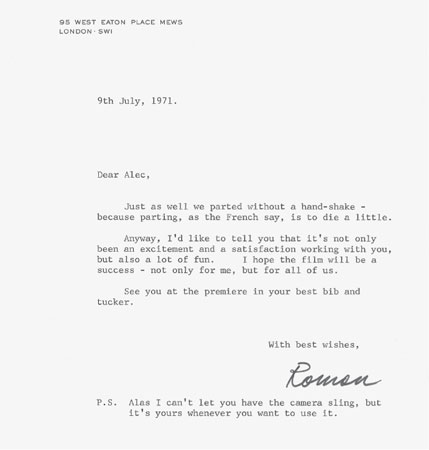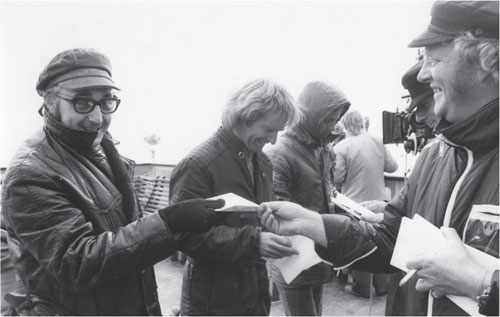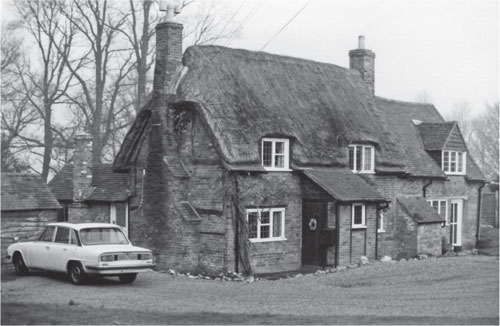Shooting 007: And Other Celluloid Adventures (19 page)
Read Shooting 007: And Other Celluloid Adventures Online
Authors: Sir Roger Moore Alec Mills

Roman Polanski and Gil Taylor experimenting with my camera harness.

Roman’s personal
au revoir
at the end of
Macbeth
. He liked the camera harness so much that he refused to let me have it back.
Macbeth
would lay down a challenge for any camera operator working with a demanding director such as Roman Polanski, who somehow drags you along to achieve his ambitious ideas, which I trust showed in the final result on the screen. One critic suggested that Polanski’s
Macbeth
mirrored the personal tragedy of his wife’s murder – an unmentionable subject on the set – while I would always remain cautious as to how I handled this extraordinary situation. Roman, however, was ready for the task ahead with his unbelievable energy now focused entirely on Shakespeare’s play, although perhaps in hindsight the Tate murder may have influenced the director’s filming, one way or another. In a strange way it may have helped him to exorcise his personal tragedy.
On a personal note, I enjoyed working with and for Roman Polanski, a challenging director with unbelievable energy which always indicated that we would get on well with each other. Happily we did; one day Roman suddenly decided to share his thoughts with me.
‘Alec, did I tell you why I chose you as my camera operator?’
Apparently it was because we were both exactly the same height and I would see everything from the same viewpoint as he did. While I found this to be an extraordinary reason for choosing me, I was more than happy to go along with the director’s very clever insight.
Driving to work in the morning I would wonder what Roman’s challenge of the day would be; his demanding mind never stopped working. One day I enjoyed a particular Polanski experience which more than likely came from Roman’s chosen cinematographer Gilbert Taylor. I would now learn an old trick, which in time I would gladly pass on in demonstrations to the students at the National Film and Television School.
Back in 1926 – long before I was born – the German cinematographer Eugen Schüfftan was credited with inventing a process of filming through a sheet of optical glass silvered on one of its surfaces – a technique which became known as the Schüfftan process. Although this technique is rarely used or even heard of these days, it is worth recording how Gil and Roman used the system to great effect, bearing in mind that this was pre-computer-generated imagery – not to mention that it was much cheaper.
There is a scene in the film where Macbeth sees an imaginary dagger in front of him, tempting him to kill Duncan, the king. To achieve this image, Gil put the mirrored glass in front of the camera lens, which was angled to reflect the ghostly floating blade positioned against a black background to the side of the camera. Looking through the viewfinder, the image I saw was of Macbeth trying to reach out to the dagger – which the actor could not see. The reflection of the ghostly blade kept appearing and disappearing before Macbeth’s eyes as he reached out to grab the weapon, which vanished when Gil dimmed the reflected light on the dagger. The Schüfftan magic was achieved without the aid of today’s technology and was captured on the original negative, allowing the result to be seen at rushes the next morning. It is a wonderful memory, if only in that it helps us to appreciate the challenges which early cinematographers had to employ; it is a sadly forgotten technique in today’s CGI world.
Polanski’s memorable version of
Macbeth
was famous for Lady Macbeth’s sleep-walking scene, with Francesca Annis being entirely naked and the stage cleared of unnecessary personnel. Prior to shooting the scene Francesca confided in me in a casual conversation over a cup of tea in the canteen, perhaps looking for comfort as to how Roman would handle this. I assured her he would handle it with taste, which of course he did.

Alfie Darling
(1974). Your job is finished – now get out! Robert Watts, the production manager, hands out the ‘Chinese handbills’ to the crew, the normal notice of your services no longer being required given to every member two weeks before the end of filming.
From the personal view of someone trying to appreciate the works of Shakespeare, I found Polanski’s version of
Macbeth
to be a rewarding experience, considering the good-for-nothing slob I had been at school. Roman’s interpretation of the play gave me pause for thought, changing my attitude to the arts so that now I could smell and breathe the atmosphere which Roman created with his masterpiece.
Jon Finch played Macbeth in this screen adaptation with Francesca Annis contributing much to the drama with her beauty and dangerous charm. Martin Shaw’s Banquo would always please, as would John Stride’s Ross, with other well-known names to delight the Bard’s audiences. However, Roman Polanski would be my star, a director who set out to challenge his camera operator so that at the end of each day I was mentally and physically exhausted. Although the dialogue was Shakespeare’s, under Roman’s direction it was performed in a modern manner that made it easier to understand.
However, my own personal tragedy was now close at hand; now would be the start of my own heartbreak. Trying not to be too dramatic with this, family issues in the wake of
Macbeth
would change my life. Life had not been easy for Lesley, with my career taking me around the world and problems inevitably arose from these separations, finally ending in our divorce. The guilty party named was the love of my work along with long hours and foreign locations. I would now pay the price.
Flashback: Mr and Mrs Metcalf, a delightful retired elderly couple, accepted our offer for their beautiful thatched cottage Cherry Trees over two other buyers. However, this came with a condition of mortgage which required alterations in the attic and the restoration of the old plasterwork. This work would reveal a deep opening which on closer inspection was discovered to be a priest hole – a seventeenth-century hiding place for Catholic priests – skilfully concealed behind the inglenook fireplace in the sitting room below.
At first we assumed the Metcalfs knew nothing of this secret hideaway and there was no suggestion of a ‘former dweller’ who shared the cottage with them; but to be fair, the priest hole was only exposed by accident, so perhaps it was unknown to them. Later, however, we would learn they were aware of a ‘presence’. Clearly this old property had an interesting tale to tell and on further research we would probably uncover more of Cherry Trees’ past history, learn more of the resident guest we inherited – a lady who had shared the company of previous owners over many years past …
All this came from a casual get-to-know-you chat Lesley had with our new neighbour, Sue Ash. During the exchange Sue’s children hinted of a ‘presence’ in Cherry Trees, but, before there was time to find out more, the subject was conveniently changed – which did not go unnoticed by Lesley. Curiosity now took over and the matter was brought up at a more suitable time, with the neighbour’s reluctant explanation going along these lines.
A short history of Cherry Trees: The Metcalf family had lived in the cottage for twenty years prior to the Mills family moving in. They were well-off business people and the cottage was well furnished, giving an appearance of material comfort with a happy atmosphere – the same impression Lesley and I had shared when we first viewed the property.
One day when her husband away on business, the lady of the house was enjoying a quiet moment with her thoughts. Gazing out the window, she saw an old man walking around the garden. When she asked him what he was doing on the property, the man explained that he had been the gardener some years earlier and was interested to see the garden. The old man went on to engage Mrs Metcalf in conversation and seemed curious to know if she had had visitors to the cottage. Not satisfied with her initial reply, he pressed on.

‘Any… unusual visitors?’ A strange question indeed …
Mrs Metcalf thought carefully about this and recalled something odd which had happened shortly after they had moved into the cottage, when she had sensed a strange feeling of someone behind her. She turned to see an old lady standing at the open door, asking her if she liked the cottage. Surprised, not knowing who the person was, Mrs Metcalf went to speak to her but the lady disappeared – gone without a trace! Mrs Metcalf looked outside but there was still no sign of the lady and the visitor had not been seen since, though there were times when she had a feeling of a ‘presence’.
The old gardener smiled knowingly; this was the answer he was hoping for. Intrigued by all this, Mrs Metcalf asked for an explanation. It would seem that the mysterious lady had lived in the cottage many years past, where she died, but came back to visit the new owners of the property. However, she would only reveal herself if there was a happy atmosphere from within – an odd phrase which was passed on to Lesley later. It was a questionable tale indeed, but with all the weird and wonderful stories handed down over the years we would never get an exact account of this past history, which was probably exaggerated over time.
I struggled while writing about this episode, which partly concerns the afterlife – something which has always interested me. With this strange account this interest would continue when the Mills family moved into Cherry Trees, where we would first learn of the permanent guest we inherited. Although I cannot claim this explanation to be verbatim, you will notice that the visitor ‘spoke’ to Mrs Metcalf. Following our earlier experience outside the bombed-out church during our courting days, Lesley and I would keep an open mind on all this, with no reason to doubt this account of something which had happened many years prior to our arrival. Nor have I added anything extra to make this explanation more interesting, but I will admit to taking a little licence to make this disclosure easier to understand.
Now the only reason I tell of this handed-down account was when something strange happened to me when Lesley moved away from Cherry Trees after our divorce.
With our children Simon and Belinda both away at their boarding schools I was now alone in the cottage, feeling very sorry for myself, very depressed. One night, sitting up into the early hours, deep in thought about the family break-up, I suddenly became aware of the old beams creaking above me, something I could not recall happening before. Why now in the early hours? Could this be our friendly visitor moving around? Listening to the movement, I was convinced the old woman was with me, probably even watching me; it could only be her. But again, can you hear a ghost or was I going mad in my loneliness?

